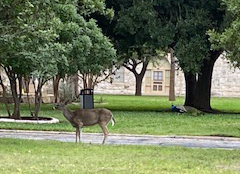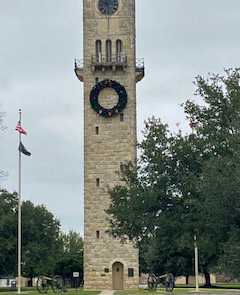I had reason to visit Fort Sam Houston last Friday – to pick up a set of prescriptions, at the new and vastly expanded BX mall, going through that one back gate where Harry Wurzbach dead-ends, after wandering past the military cemetery, the golf course and the Towers at Park Lane. It’s been a familiar haunt to me for years, even if I was never assigned there, or had reason to go to any offices when I was active duty. It was an open post back then – so wide-open that it was only embarrassment that kept the Fort Sam EM/NCO club from being listed as off-limits to Air Force personnel. (There was, according to scuttlebutt, a dissolute and faintly dangerous element which used to hang out at that club.) I used to take a short-cut through the post on North New Braunfels to circumvent traffic jams on the Pan-Am Highway, when I had to drive through to Lackland AFB from where I lived on the north-east side of town. I was basically familiar with the older part; the stately red-brick Victorian senior officer-housing mansions along the northern and western side of the monumental, L-shaped parade ground, and the series of enormous three-story neo-Spanish Colonial style tile-roofed administration buildings and barracks which lined the opposite side. The mansions along “colonel’s row” always looked well kept, but in the few years after I retired, some of the older buildings began looking pretty ragged, decrepit even. I sometimes wondered if the Army had given up on painting them altogether, trimming shrubbery and pulling up weeds in the lawns around. Part of the peace dividend, I guessed.
Fort Sam Houston – familiarly known as “Fort Sam” is itself a pretty historic place – nearly as historic as the Presidio of the Alamo, the military post that it replaced, late in the 1870s. The Alamo, first established as the Spanish military HQ in Texas, went right on being used as a military post, through possession by Mexican soldiers, Texian volunteers, the US Army, and the Confederate States Army. The US Army took possession again, following the Civil War, when it was headquarters and logistical supply base for the US Army in the trans-Mississippi West, in the days of the Indian wars. But by the mid-1870s, the Army had outgrown the crumbling adobe and stone structures around Alamo Plaza. The city had also spread far enough to surround the old Presidio and considerably cramp military operations. The Army suggested closing the post to save money. The city fathers, probably horrified at the thought of losing the custom of the Army post, as well as the presence of a relatively free-spending garrison, immediately donated 92 acres of land on the low hills north of town and well outside the-then city limits.
For the Army it was a chance to start afresh, building exactly what they needed; generous warehouse space to store Army supplies brought up from Galveston and other coastal ports, offices for the supply sergeants and officers to work in, facilities to care for the horses, and the soldiers, and their families. A birds-eye map of San Antonio done in the 1880s clearly shows the original Fort Sam establishment; a single structure called the Quadrangle, a range of two-story buildings around an open courtyard adorned at one end with an ornate clock tower. The Quadrangle also served as an open-air prison in 1886. Geronimo, the last of the fighting Apache chiefs and some of his warrior band were held in the quadrangle for 40 days, while the federal government decided what to do with him. It’s only a legend that the small herd of tame deer currently living in the Quadrangle are those descended from a herd provided to Geronimo’s band as part of their ration issue.
By the turn of the last century, Fort Sam was the second largest military post in the United States. Practically every Army officer serving between the 1880s through World War II passed through Fort Sam at one time or another. Teddy Roosevelt’s “Rough Riders” rendezvoused and trained there before shipping to Cuba to charge up San Juan Hill. Whenever I pass by the open stretch of the parade ground, I am reminded that it was on that patch of level, open ground that then-Lieutenant Benjamin Foulois of the Signal Corps took off in a 1909 Wright Flyer, dubbed “Army Airplane #1” for a series of demonstration flights in 1910 – four takeoffs, three successful landings, the series concluded with a crash. Lt. Foulois was, for an interesting early period in military aviation, the entire Air Corps/Air Force. Fort Sam also supplied the men and material for General John “Black Jack” Pershing’s expedition into Mexico, chasing after Pancho Villa in 1916. At the very far end of the parade ground is the old Brooke Army Medical Center (built in 1936), formerly the Station Hospital, replaced in the 1990s with an even larger and more splendid complex to the east of Fort Sam. Dwight Eisenhower met and married his wife, Mamie Dowd, while stationed at Fort Sam as a young lieutenant. General Billy Mitchell was assigned to Fort Sam after being court-martialed and demoted. At the end of WWII training of Army medical personnel was consolidated there, and military medical training for all the other armed services was moved to Fort Sam more than a decade ago. This makes it a very busy training facility; it is a showplace for military medicine, which is the reason that I go there for regular visits like today.
I have read that if the post is ever closed, and all facilities revert to the city of San Antonio (like the Presidio in San Francisco) that the stock of historic buildings in the city inventory would double right then and there. Most of those buildings are still in use, though – at present, only the Quadrangle is open to the general public. But there are two museums, also open to the public, that between them give a very good idea of the scope of Fort Sam’s history and present missions: The Fort Sam Houston Museum, and the US Army Medical Department Museum.


